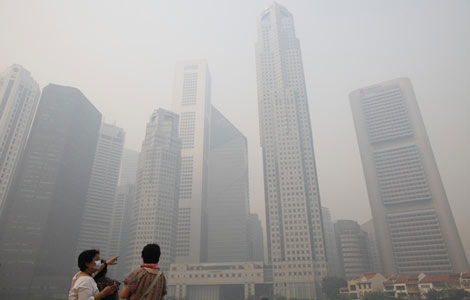Environmental impact system has shortcomings
Updated: 2013-06-21 17:15
By Hou Liqiang (chinadaily.com.cn)
|
||||||||
Experts called for improvement of the environmental impact assessment system on Thursday when the Chinese Academy of Social Science launched its 2013 green book of eco-cities.
The book, The Report On the Development of China's Eco-Cities (2013), summarizes the achievements of the top 10 eco-cities and also the problems that exist in building eco-cities.
One of the problems mentioned is the inadequate environmental impact assessment system.
"Some projects were launched in a disguised manner. The public isn't given enough access to relative information and chances to take part in the environmental impact assessment," the book reports.
The environmental impact assessment of some projects were mere formalities and the scholars who took part in assessments seldom made objections, Lu Dadao, a scholar at the Chinese Academy of Sciences and member of the National Planning Expert Committee, told China Daily after the book launch.
Although the Ministry of Environmental Protection issued an order last year that China's environmental protection agencies should publish environmental impact assessment reports on their websites from Sept 1 to make them available to the public, Lu said that is far from enough.
"What they do is only put the report on the Web. They never promote that to let more people know.
"What's more, the regulation only asks to display the report for 10 days. Many people aren't able to see it before it is removed," said Ma Jun, director of the Institute of Public and Environmental Affairs.
Open hearings that involve the public are not necessary according to the current regulation, so agencies can choose to hold a discussion or seminar from which the public is excluded, Ma added.
The government needs to extend the public display time of the reports and make hearings involving the public mandatory, Ma said.
The indexes used to select the top 10 eco-cities were forest coverage rate, days with good air quality, biodiversity, quality of water in lakes and rivers, average public green land area, the rate of innocuous disposal of domestic garbage, energy consumption per GDP, average life expectancy, attainment rate of industrial waste water, GDP per person, public awareness of ecological knowledge and laws of environmental protection and the satisfaction rating of the public on the urban ecological environment.
The top 10 Eco-cities
Shenzhen, Guangdong province
Guangzhou, Guangzhou province
Beijing
Nanjing, Jiangsu province
Zhuhai, Guangdong province
Xiamen, Fujian province
Hang Zhou, Zhejiang province
Dongguan, Guangzhou province
Shenyang, Liaoning province
Source: The Report On the Development of China's Eco-cities (2013)
Most Viewed
Editor's Picks

|

|

|

|

|

|
Today's Top News
Silk Road history illuminates new links
Tourist board touts Yangtze cruise
Chinese buying up San Francisco real estate
New balance called for on US strategy in Asia
China slams US human trafficking report
Snowden's future hangs in balance
China urges resumption of six-party talks
SEC charges China-based firm with fraud
US Weekly

|

|















